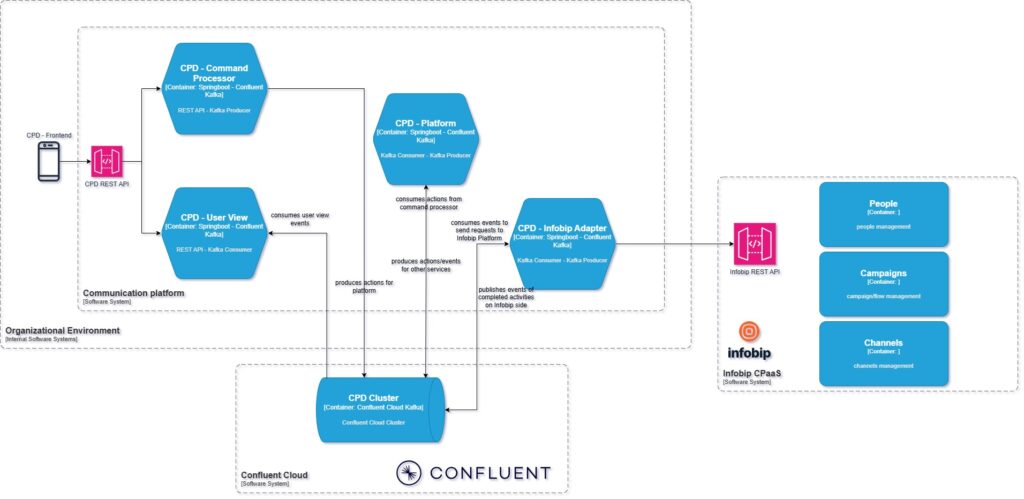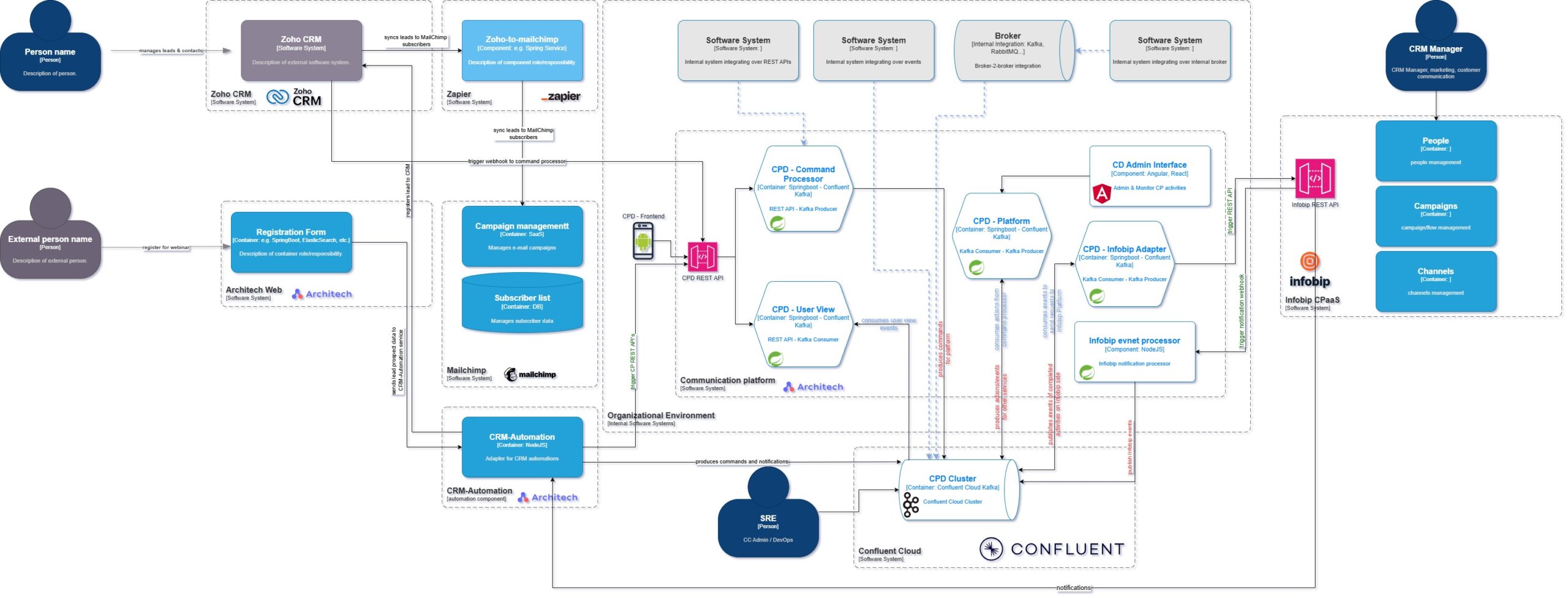Revolutionizing Customer Engagement with Event-Driven Architecture
In a rapidly evolving digital landscape, customer engagement has become more critical than ever. Real-time interaction can make the difference between a satisfied customer and a lost opportunity.
This blog post will demonstrate how Event-Driven Architecture (EDA) can be leveraged to build a responsive communication platform that facilitates real-time customer engagement, as presented in our recent webinar hosted in collaboration with Confluent Inc. and Infobip.
Understanding Event-Driven Architecture
Event-Driven Architecture is a software design pattern in which decoupled applications can asynchronously publish and subscribe to events. This design allows systems to react to events in real-time, facilitating responsive and scalable solutions.
Key Characteristics of EDA
Asynchronous Communication: Components communicate through events without waiting for a response, enhancing system responsiveness.
Decoupling: Producers and consumers of events are independent, allowing for flexible scaling and maintenance.
Scalability: EDA can handle high volumes of events and data, making it suitable for large-scale applications.
EDA is a fundamental paradigm in software design that focuses on producing, detecting, consuming, and reacting to events. An event can be defined as a significant change in state, such as a user clicking a button, a sensor sending a temperature reading, or a financial transaction being completed. EDA’s core advantage is its asynchronous communication model, where components, or services, do not communicate directly but rather through events that are published to an event broker or bus.
This decoupling allows services to be independently developed, deployed, and scaled, significantly enhancing the flexibility and resilience of the system. Each event is essentially a message that contains information about a state change, which other components in the system can consume and react to appropriately. This pattern is particularly useful in scenarios requiring real-time processing and responsiveness, such as online financial transactions, real-time analytics, IoT applications, and complex event processing in distributed systems.
Components
In EDA, the architecture typically involves three main components: event producers, event consumers, and event brokers. Event producers are responsible for detecting changes in the state and publishing these events to the event broker. Event consumers subscribe to specific types of events and execute certain actions when those events are detected. The event broker acts as the intermediary that ensures reliable delivery of events from producers to consumers. This broker is often implemented using message-oriented middleware technologies like Apache Kafka, RabbitMQ, or Amazon Kinesis.
One of the key benefits of this setup is the inherent scalability and fault tolerance it provides. Since producers and consumers are decoupled, each can scale independently based on demand. Furthermore, the event broker can replicate events across multiple nodes, ensuring high availability and resilience against failures.
This architecture also supports eventual consistency, where systems are designed to be consistent in the long run, even if intermediate states might temporarily diverge. EDA’s inherent characteristics make it an ideal choice for building responsive, scalable, and maintainable systems in modern software engineering.
Commands and command processors
In the context of EDA, commands and command processors play crucial roles in the system’s operation and workflow management.
Commands are explicit requests to perform a specific action or change a state, typically initiated by a user or an external system. These commands encapsulate all the necessary information required to execute an action, ensuring that the intent and context are clear and unambiguous.
Command processors, on the other hand, are dedicated components responsible for handling these commands. When a command is issued, the command processor validates it, executes the necessary business logic, and then publishes events to the event bus or broker to notify other components about the change in state. This separation of concerns allows for greater modularity and scalability, as command processors can be independently developed, tested, and deployed.
By processing commands asynchronously and generating events, command processors facilitate a responsive and decoupled system architecture, enabling efficient handling of complex workflows and ensuring that different parts of the system remain loosely coupled yet highly cohesive.
Webinar
In our recent webinar, we delved into the intricacies of using Event-Driven Architecture (EDA) to enhance real-time customer engagement. A pivotal aspect of this architecture is the use of commands and command processors, which are essential for handling specific user requests and actions within the system. Commands, such as user registration or purchase initiation, encapsulate all necessary information for executing a particular task. These commands are processed by command processors, which validate and execute the necessary business logic. For instance, when a user signs up on our platform, the command processor handles the registration process, publishes relevant events to the event bus, and triggers subsequent workflows like sending a welcome email or updating the user engagement metrics.
The architecture we presented, in collaboration with Confluent Inc. and Infobip, exemplifies the power of EDA in creating a robust real-time communication platform. Our solution integrates seamlessly with various components, from the CPD Command Processor to the Infobip Adapter, ensuring that every event, from user actions to system notifications, is handled asynchronously and efficiently. This decoupling allows for independent scaling and maintenance of each component, ensuring the platform can handle high volumes of events and data without bottlenecks.
For example, during a marketing campaign, the command processors can manage numerous user interactions in real-time, triggering personalized messages through Infobip’s platform and ensuring immediate and relevant customer engagement. This architecture not only enhances the user experience by providing timely responses but also allows businesses to scale their operations seamlessly, adapting to growing demands and ensuring continuous engagement with their customers.
Core Components of the EDA Solution
The CPD Platform, as illustrated in the architecture diagrams, comprises several core components designed to facilitate real-time customer engagement through Event-Driven Architecture (EDA).
Confluent
Central to this architecture is the CPD Cluster, which operates on Confluent Cloud, ensuring scalability and fault tolerance. This cluster serves as the backbone for the platform’s event processing capabilities, managing the flow of events between various components and ensuring reliable message delivery.
Confluent Cloud, built on Apache Kafka, provides a fully managed platform that supports real-time data streaming and event processing at scale. Its architecture ensures high availability and fault tolerance, making it ideal for handling the large volumes of data generated by modern applications. Confluent Cloud offers several key benefits that enhance the capabilities of an EDA system:
- Elastic Scalability: The platform can scale resources dynamically to meet varying demand, ensuring consistent performance during peak usage periods.
- Data Durability and Reliability: With features like data replication and automatic failover, Confluent Cloud ensures that event data is preserved and accessible, even in the event of infrastructure failures.
- Low Latency: Confluent Cloud’s architecture is optimised for low-latency data streaming, which is crucial for real-time applications that require immediate processing and response.
CPD – Communication Platform Demo
The CPD Platform component itself acts as the orchestrator, consuming actions from the Command Processor and generating events for other services. This modular setup allows for easy extension by adding new event types or integrating additional services without disrupting the existing infrastructure.
If needed, you can increase modularity by developing “CPD Platform” components for specific use case, or set of common use cases. This would go towards orchestrator pattern where you have one service ( one process ) which orchestrates services, commands and events around one use case.
For instance, integrating a new customer feedback system would involve producing and consuming specific events related to feedback collection and analysis, seamlessly incorporating it into the platform’s workflow.
The CPD User View and CPD Infobip Adapter are pivotal components in delivering a responsive user experience. The User View component consumes events related to user interactions, ensuring the system’s state is updated in real-time and accurately reflects user activity. This is crucial for maintaining an up-to-date user interface and providing immediate feedback to users.
Extending the User View involves subscribing to new event types or enhancing processing logic to handle additional data, ensuring the platform remains adaptable to evolving business needs.
Infobip
Infobip Adapter, on the other hand, interfaces with the Infobip CPaaS, consuming events to send requests and publishing events upon completion of activities. This integration enables the platform to leverage Infobip’s robust communication capabilities for tasks such as sending notifications or processing user responses. Extending the Infobip Adapter can involve incorporating new communication channels or enhancing existing ones, ensuring that the platform can scale and adapt to provide comprehensive real-time customer engagement solutions.
Infobip’s Communication Platform as a Service (CPaaS) integrates various communication channels, enabling businesses to engage with customers through SMS, email, voice, and other messaging platforms. This integration allows for a unified communication strategy that can be tailored to the preferences and behaviours of individual customers. Key aspects of Infobip CPaaS include:
- Omnichannel Engagement: Infobip CPaaS supports a wide range of communication channels, ensuring that businesses can reach their customers on their preferred platforms.
- Scalability: The platform can handle high volumes of interactions, making it suitable for businesses with large customer bases or those experiencing rapid growth.
- Analytics and Insights: Infobip provides tools for monitoring and analysing communication effectiveness, allowing businesses to optimise their engagement strategies based on real-time data.
Integration within a Comprehensive Environment
The broader architecture diagram illustrates how our core solution integrates within a larger ecosystem, interfacing with various internal and external systems.
In real-life, we have more complex environments and systems integrated in one use case. To enable and facilitate this kind of complexities, we use EDA as “glue” that connects all required components.
Real-World Applications and Benefits
The practical applications of this architecture are vast, particularly in scenarios requiring real-time customer engagement. For example, in financial services, such an architecture can provide immediate fraud detection and personalised financial advice based on real-time data analysis. In e-commerce, it can enhance customer experiences through real-time recommendations and notifications, increasing engagement and conversion rates.
Benefits of EDA in Customer Engagement
- Immediate Response to User Actions: By processing events as they occur, the system can provide immediate feedback and interactions, essential for enhancing user satisfaction.
- Scalable and Resilient: The platform can scale to accommodate growing user bases and data loads, ensuring consistent performance. Kafka’s built-in features for data replication and fault tolerance further enhance system reliability.
- Integration with Multiple Channels: The ability to integrate seamlessly with various communication channels through platforms like Infobip CPaaS allows businesses to engage customers on their preferred platforms, creating a cohesive and unified customer experience.
Conclusion
Event-Driven Architecture, as exemplified by the CPD platform, offers a robust framework for building scalable, real-time communication systems. By leveraging the strengths of Confluent Cloud and Infobip, businesses can create highly responsive systems that not only meet the demands of modern customer engagement but also provide a flexible foundation for future growth and innovation. This architectural approach not only addresses current business needs but also positions organisations to adapt to the rapidly changing digital landscape, ensuring long-term success and customer satisfaction.








